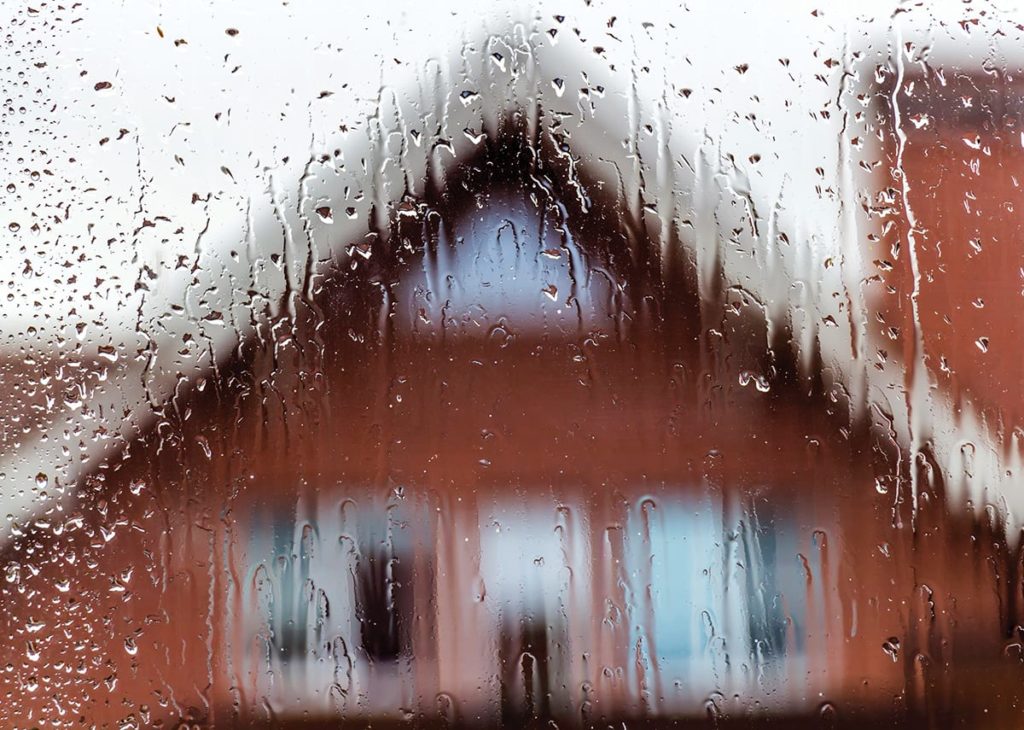By R. Matranga, B. Doran, A. Fream, C. Baude, E. Bousseau, and M. Secher, OMNOVA Solutions, Specialty Solutions
The development of an effective waterborne technology for exterior paints has become a significant challenge in the architectural coatings market due to the growing expectations of end users (total cost of ownership), diversification of materials used for exterior walls and siding, and the continuous trend towards VOC reduction. This article describes a new product based on our company’s Low Exudation Binder (LEB) platform, designed for formulation of exterior paints, where pure acrylic binders are typically used for reasons of excellent color retention in very deep tones. The new binder possesses the advantages common to those of the LEB technology, namely very low surfactant leaching, excellent resistance to efflorescence, and long-term adhesion, and in addition, very early rain resistance, allowing the application window to be extended. Furthermore, paints formulated with the new binder have very low VOC emissions, and are in-line with all the most stringent, current environmental requirements.
INTRODUCTION
The main feature that makes water-based coatings in general, and exterior paints in particular, attractive from an environmental and safety point of view, is that they release water rather than organic compounds when drying. This desirable constituent, however, is also the main cause of most of the problems that customers of paint companies, whether do-it-yourselfers (DIYers) or professional painters, face in terms of exterior paint application in all regions. Solvent-based coatings continue to be used for their superior performance, mainly for professional use, where tolerance to marginally prepared surfaces or low temperature during application is required. Their use is still permitted despite VOC regulations and the like, because no acceptable alternative presently exists for “all weather” exterior coatings. However, there is a demand in the market for water-based coatings that close the gap in performance between the current water-based products and solvent-based coatings.
PROBLEMS WITH WATER-BASED MASONRY COATINGS
The Weather: Application and Drying
The physical properties of water are dramatically different from those of other solvents used in coatings. Most water-based architectural coatings today employ polymer dispersions in which water serves as the dispersion medium. The coating formulations form films by a process of coalescence. As such, it is important that the application, drying, and coalescing conditions are controlled. Important parameters in this respect are temperature, relative humidity (RH), and air movement.
For successful application, the typical guidance from paint manufacturers is that the application window for water-based coatings is limited to RH between 40% and 60% and to temperatures between 50°F (10°C) and 90°F (32°C). In practice, because “Mother Nature” is not as cooperative as we would like, the application window for exterior coatings can be extended to more than just a handful of “ideal” days, by expanding these ranges somewhat (Figure 1).
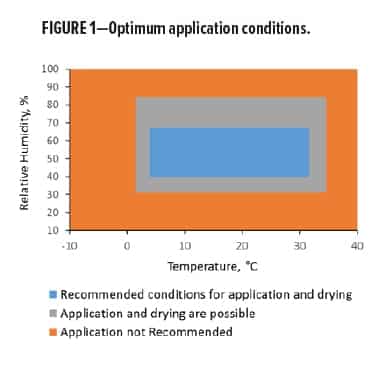
The Weather: Resistance to Early Rain
An obvious problem with water-based coatings is their susceptibility to “wash-out” by rain occurring during or shortly after application. So, while the paint film is still sufficiently sensitive to water, it can be re-dispersed especially by hard, wind-driven rain, and washed off the substrate. The uncertainties of the weather mean that this cannot be completely avoided, and it can be costly to clean up and recoat when it happens. For a waterborne coating to resist rain wash-out, it needs to coalesce and develop hydrophobicity to a state where it is not readily re-solubilized by water droplets. This is not easy to achieve with polymer dispersions, but is possible, as will be demonstrated later.
Exudation or Surfactant Leaching/Staining
A quick internet search will show that surfactant leaching1 (also known as surfactant or exudate staining, streaking, weeping, snail trails, etc.) is a paint defect listed by many paint manufacturers in the “Common Paint Problems” pages of their websites. As the various terms imply, exudation gives rise to unsightly stains on the surface of freshly applied paint.
All waterborne paints contain water-soluble materials. As a general rule, the properties and ultimate performance of all waterborne paints depend on the concentration of these water-soluble materials that remain in the film after drying. In the case of exterior masonry coatings, under normal field conditions these materials are eliminated by rainwater or condensation during the first few weeks’ life of the paint, without affecting the appearance.
The problem of exudation of water-soluble components to the surface is liable to occur on any waterborne exterior paint when exposed to harsh, wet weather conditions. This problem often occurs on paint that has been applied near dusk where, with the drop in temperature that naturally follows as day turns to night, dew or condensation forms on the surface of the fresh paint, causing surfactant to migrate to the surface. After drying, this phenomenon produces visible stains.
Other Common Problems
Efflorescence is caused by water-soluble salts present in the masonry substrate migrating via capillary action to the surface. If the film allows permeation of water as a liquid from the substrate, the salts pass through the film and form unsightly deposits on the surface of the paint when the water evaporates. However, if the film is not sufficiently permeable to liquid water,
and the adhesion of the paint film to the masonry is not high enough, salt deposits build up under the film and result in blistering, peeling, or flaking of the paint.
Additionally, exterior durability, especially in terms of color or tint retention, is of prime importance for a facade coating. This depends not only on the polymer chemistry, but also on the efficacy of film formation (coalescence). Even the best binders will not perform as expected if film formation is deficient. Incomplete film formation can give rise to early film degradation on exposure to the elements, resulting in excessive chalking or fading. Over the past few years, consumer preference for bright, deep tones for facades has increased significantly. At the same time, due to regulatory or “green” reasons, the colorant industry has moved toward lower VOC product ranges containing higher amounts of surfactants. As a result, color retention has become the origin of increasing customer claims. Any improvement in film-forming ability of new paint binders, such as better tolerance to climatic conditions during application and drying of exterior coatings, is thus beneficial in ensuring extended durability.
POLYMER DEVELOPMENT: LEB PLATFORM
Polymer Design Considerations
Polymer design considerations have been outlined in some detail in previous publications.2,3 Using the best of modern raw materials and the diverse toolbox of polymerization methods, a latex polymer that minimizes leaching of water-soluble components from paint films has been developed. In the LEB technology, the latex or polymer dispersion is stabilized with anionic groups bonded to the polymer, and a multi-step process designed to favor the distribution of functional monomers at surface of particles is used, resulting in a much-reduced “free” surfactant content.
Need for Pure Acrylic Version of LEB
The first product to be developed and launched using the LEB platform was a styrene acrylic polymer designed especially for high build, flexible masonry coatings, which are widely used in the European market. The second generation of this technology platform has now been developed to serve different segments of the market and different regions of the world. This new product provides a very low VOC, pure acrylic polymer for formulation of thin film coatings, especially for American and Asian markets.
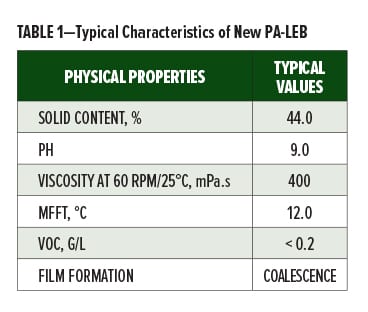
Thus, in addition to the well-known key advantages of the LEB technology, namely outstanding exudation and efflorescence resistance, the Pure Acrylic LEB (PA-LEB) product offers some incremental modifications to allow formulation of exterior paints with low-VOC content, meaning, it can be formulated below 50 g/L according to the EPA Method 24 while simultaneously maintaining a low MFFT [(film formation below 35°F (2°C)]. The polymer’s composition has been adjusted to cope with the requirements of regions with high UV resistance, while maintaining the best compromise of film strength (tensile/elongation) and resistance to dirt pick-up. Of course, the product has been designed without APEO-containing surfactants, and does not contain added formaldehyde. The basic characteristics of the new PA-LEB latex are shown in Table 1.
EXPERIMENTAL: TEST METHODS
The Nature of Exudates from Water-based Paints
An extensive analytical study, using mainly thermal gravimetric analysis (TGA), gas chromatography/mass spectrometry (GC/MS), and pyrolysis/GC/MS has been carried out on exudates obtained using the method outlined in the next section. Both commercial products and formulations prepared using known ingredients, including LEB and competitive binders, have been tested. The objective was to identify the chemical nature of species present in leachates, and their source in terms of raw materials used in the formulations.
Exudation Resistance (Evaluation of Leaching of Surfactants and Water-soluble Components)
At the start of our development, no relevant international standards existed for measurement of leaching of surfactants. This necessitated the development of an in-house method. Although standards now exist,4,5 these still are not considered to be reliable for facade coatings subject to wind-driven rain because they involve continuous immersion in water.
The aim of the in-house method is to predict the behavior of paints in terms of release of water-soluble materials and surfactants during the early stages of drying under adverse conditions.
In this method, paints are applied by brush to the exterior of plastic cans, at a spreading rate of 250 sq ft per U.S. gal. After 16 h of drying, the painted cans are filled with water and ice, and then placed in a climatic chamber at 77°F (25°C) and 90% RH for a period of 90 min. The leachate is collected during the test in a cup positioned below the can. The amount of leachate is measured by weighing the exudates after drying for 4.5 h at 140°F (60°C), and is expressed in percent per weight of dry paint applied.
Efflorescence Resistance
A coating is applied in two coats (with 24 h between coats) to porous clay bricks, leaving a few centimeters uncoated at the bottom of the brick. After 24 h of drying, the bricks are placed in a saturated sodium chloride solution for several weeks. During the test, water or salt is added to the solution as needed to ensure that the level remains constant. Changes in film appearance (blisters, salt deposits, cracking, etc.) are observed over a period of up to three weeks.
Shower Test (Evaluation of Resistance to Early Rain)
A primer is applied at 250 sq ft/gal to fiber cement panels. After 24 h of drying at ambient temperature, the panels are conditioned in a controlled temperature/humidity chamber at 37°F (3°C) and 90% RH for 30 min. Then, the paint under test is applied at 250 sq ft/gal and allowed to dry for 30 min at 37°F (3°C) and 90% RH in the chamber. For the test, panels are placed under a simulated shower for 3 min. Visual observation and photographing of the panel are carried out.
Q-UV Exposure and Exterior Weathering
A Q-UV apparatus is set to perform alternating cycles of 4 h of UVB (313 nm) at 158°F (70°C), and 4 h of condensation at 104°F (40°C). The paints are applied in one coat with a wire-wound drawdown bar at 12 mils (300 mm) WFT on aluminum Q-panels. After one week of drying, paints are exposed to cycles during 1000 h. Appearance and color changes (CIE L*, a*, b*) are checked every week.
Exterior weathering is in progress at our Technical Centre site in France, just south of Paris. Fiber cement panels are coated by brush with two coats of paint, applied at 24-h intervals, and allowed to dry for one week at ambient temperature before being placed on the weathering racks. Appearance and color changes (CIE L*, a*, b*) are checked quarterly.
Adhesion
Adhesion is tested according to ASTM D3359. Paints are applied at 6 mils (150 mm) WFT and allowed to dry for 24 h and 7 days at 73°F (23°C) and 50% RH. Adhesion results are rated from 5B (0% area removed) to 0B (greater than 65% area removed).
Resistance to Mud-cracking
A textured acrylic coating is applied to fiber cement panels. After one week of drying at room temperature, the application of the coating to be tested is made in two coats at 200 sq ft/gal. Panels are exposed for three weeks in Q-UV (UV-B, 313 nm). Visual inspection of the paint film is carried out periodically, both by eye and under a low power microscope to detect signs of cracking. Experience has shown that this method also correlates well with resistance to grain cracking on wood, a frequent requirement for “house paints” where masonry is not the sole intended substrate for the paint.
Crack Test on Wood
The paint is applied in two coats (24 h of drying) by brush at 250 sq ft/gal on all faces of beech panel (6.0 x 2.4 x 0.4 in.). After three days of drying at 73°F (23°C) and 50% RH, 20 cycles of aging are performed as follows:
- 4 h at room temperature
- 3 h at 122°F (50°C)
- 1 h of immersion in water
- 16 h at -4°F (-20°C)
At the end of each cycle, the panel is weighed to determine the quantity of water penetrating the wood through the paint film, and a visual inspection is carried out.
RESULTS AND DISCUSSION
Analysis of Exudates from Water-based Paints
Water-based facade paint formulations typically contain 15 to 20 ingredients, including pigments, colorants, extenders, and a number of additives in addition to the binder. Each raw material is often a mixture rather than a single specific chemical. For example, an additive such as a rheology modifier can contain solvents, preservatives, and surfactants, in addition to the main chemical species that functions as the thickener. Even those which would normally be regarded as “inert” raw materials, such as pigments, contain water-soluble components, for example, from surface treatments to improve dispersibility. Consequently, a paint formulation contains dozens of individual chemical species, many of which are water-soluble to a greater or lesser extent. Therefore, they can potentially leach out of the paint film under the right conditions.
A typical chromatogram resulting from an analysis of exudate of facade paint by pyrolysis/GC/MS (as shown in the left part of Figure 2), contains many peaks, and demonstrates clearly the complexity of the chemical nature of the exudate. In contrast, the chromatogram for a paint of the same formulation prepared with the new PA-LEB (right side of Figure 2) shows considerably fewer peaks and, therefore, less complexity.
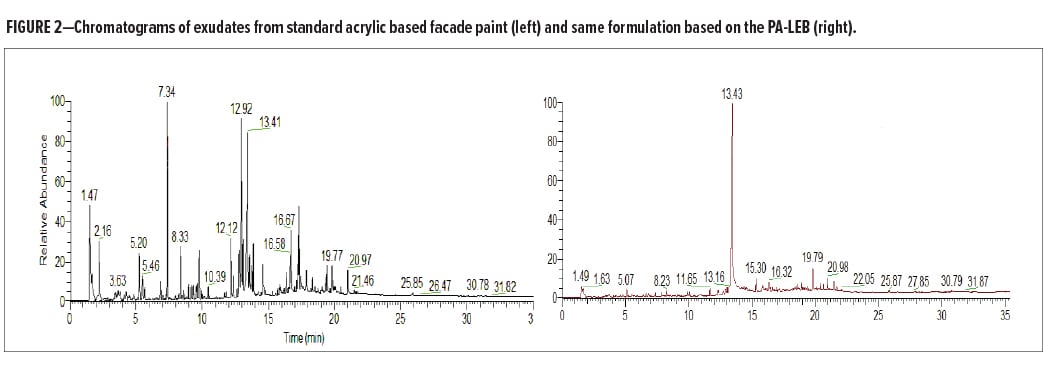
To understand from which raw materials the individual chemical species found in the exudate are derived, a series of paints was prepared omitting each ingredient of the formulation in turn. Then, the exudates were collected and analyzed. In this way, it was possible to identify the source of each chemical species found in the exudates.
The mechanism by which water-soluble species, even though present in the paint film, are prevented from leaching from the paint is linked to the morphology of the polymer binder. It acts as a sort of “fishing net” that traps and holds certain chemical species within the film, thus preventing them from ending up in the exudate.
The analytical study is continuing in an effort to generate an in-depth characterization of the mechanism, and the results of this research will form the basis of a future technical paper.
APPLICATION OF PA-LEB IN EXTERIOR COATINGS
Exterior coatings have two primary functions. The first is to protect the exterior surface of buildings from degradation by weather and pollution. Nowadays in the United States, exterior walls can be finished with a wide array of materials: bricks, concrete, mortar, metal claddings, fiber cement, wood, or vinyl sidings. In some cases, several of them can be found on different parts of the facade. Even if each material requires a proper surface preparation before application of a specifically formulated primer, the possibility of using one single product as a topcoat can represent significant savings in labor costs.
The second function of exterior coatings is to decorate the substrate. This aesthetic function is the more easily recognized one, because the immediate effect of the paint application is very visible. The trend for the use of deep colors has experienced an important growth both in the DIY and trade markets, along with the intensification of “point of sale” tinting machines. The benefits of this preparation method using calibrated bases and colorants can be easily understood: quick tint preparation, tailor-made color, low stock of tinted paint, etc. However, the formulator is in fact introducing more water-sensitive additives into exterior paint formulations to improve the compatibility with colorants. Furthermore, with zero VOC becoming the standard, colorants also contain water-soluble components in higher quantity. As described in a previous paper,3 the impact of water sensitivity is directly linked to an increase in exudation of the coating and a decrease in resistance to efflorescence.
Based on the new PA-LEB, formulations of exterior flat paint have been developed. In order to have a coating that protects the substrate from driving rain, but which is also sufficiently breathable to allow moisture vapor in the substrate to escape, the PVC and PVC/CPVC ratio have been adjusted to ensure that the film possesses a good balance of MVTR6 and liquid water transmission rate,7 in line with the well-known Kunzel theory of facade protection.8 Formulation is a white base for preparation of pastel shades, and the second is a clear base for extra deep tones. These formulations can be used as starting points to formulate the intermediate bases. Indeed, modern tinting systems comprise three or four bases of different tinting strengths and titanium dioxide contents. Focusing the study on the opposite calibrated bases only allows for the identification of most of the potential issues, while avoiding adding too much complexity. Formulations are presented in Table 2.
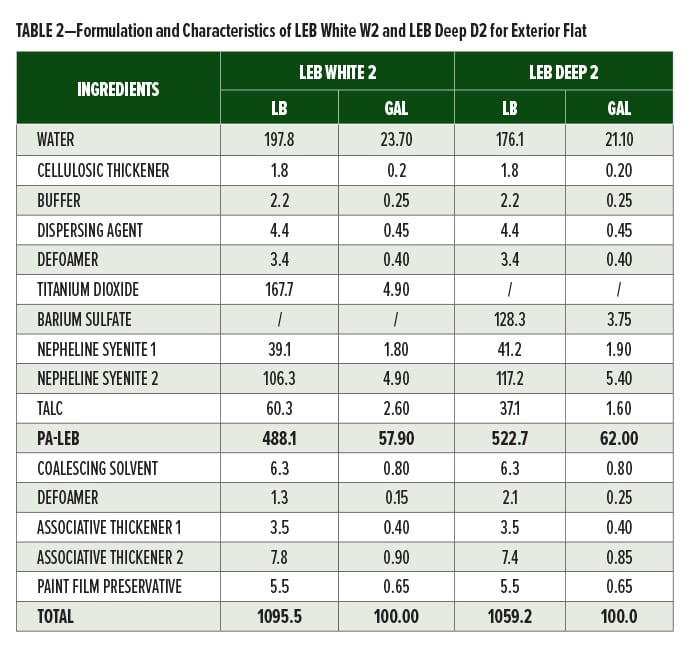
ASSESSMENT OF LEB WHITE W2 AND LEB DEEP D2 PERFORMANCE
The performance of the new PA-LEB binder has been assessed in the formulations presented in Table 2, and compared to White and Deep Bases from three benchmark brands of the U.S. market owned by major coating suppliers. The basic characteristics of the commercial paints and the experimental formulations are given in Table 3.

Exudation Resistance
For the White Bases, evaluation of exudation resistance was made on the paint without colorant, and with the addition of two phthalocyanine blue colorants used in tinting systems from two major paint manufacturers. The Deep Bases were tested after the addition of the same colorants, and with a third phthalocyanine blue from a universal range of an international colorant supplier. The amount of colorant added has been determined according to the average recommended level for each type of base. Results presented in Figure 3 are expressed as percentage of exudate released per weight of dry paint applied.
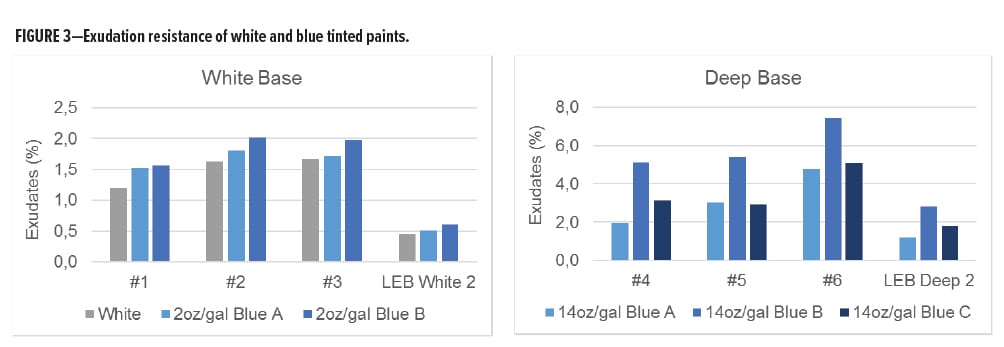
The design of the new PA-LEB polymer results in resistance to exudation that is better than that of commercial paints based on conventional binder technologies. This is in line with analytical results, and confirms the benefits of the LEB platform to optimize this property.
For the White Base, with no added colorant the exudation is divided by a factor of three: the amount of hydrophilic substances present in the binder and prone to exudate is much lower. It is also interesting to note that the addition of a colorant increases the exudation to a lesser extent in formulations based on the PA-LEB: the binder limits the exudation of some of the chemical components present in these colorants.
In the Deep Base, since the amount of colorant is higher, the quantity of exudate can be very important (up to 7%), illustrating the reasons why it can be so difficult to minimize the risk of exudation issues with deep tone colors on building site. Nevertheless, in this type of formulation as well, the LEB technology allows the quantity of exudate to be divided by a factor of two or three.
Efflorescence Resistance
Efflorescence resistance was assessed after three weeks of exposure to salt solution. The pictures in Figure 4 show the ability of the paint to maintain good adhesion to the substrate and block the development of salt deposits on the surface of the film or at the film/substrate interface, in spite of the osmotic pressure applied on the coating.

The formulations based on PA-LEB demonstrate efflorescence resistance superior to that of conventional water-based binders. Among the commercial paints selected in our study, only one (#1 and corresponding Deep Base #4) attained the performance of our experimental formulations based on the PA-LEB binder. Part of the explanation can be found in the PVC/CPVC ratio, estimated at a lower level for formulations #1 and #4 compared to other samples. As described previously, optimization of water resistance as a result of the stabilization system used in LEB, allows the formulator to develop new exterior flat paints with good resistance to efflorescence, limiting potential problems when salts might be present in mineral substrates.
Shower Resistance
Paints are visually assessed after 3 min of the previously described shower test carried out after 30 min of drying time in severe climatic conditions (37°F (3°C)/90% RH). These conditions have been found more differentiating than shorter drying time with climatic conditions closer to the “ideal” ranges. The aim is to test the wash-out resistance of the coatings when film dries in conditions that were not expected to occur when the painting job was begun, due to sudden change in the weather (temperature, relative humidity, wind).
To obtain a substrate with even porosity, a masonry primer is applied on fiber cement panels used for the test (“substrate before painting” on the left in Figure 5). This first coat is tinted in a light blue color to obtain a visual contrast with White Bases and Deep Bases tinted in dark blue, applied subsequently.
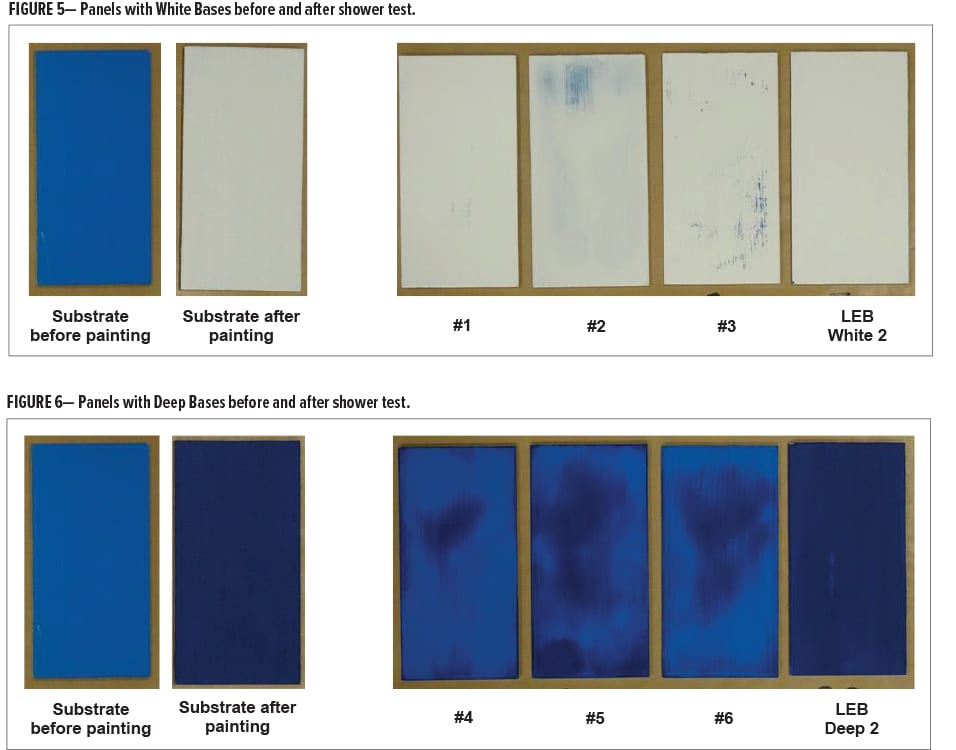
The early water resistance demonstrated by PA-LEB in the experimental White Base is achieved as a result of robust coalescence and film hydrophobicity developed during the early stages of drying. This translates into increased security during paint application in practice. Under the same conditions of testing, White Base #2 and #3 show medium resistance. In Deep Base formulations, when a high level of colorant is added (close to 10% by weight) the benefit of the PA-LEB is even more obvious, highlighting the interest of this type of technology for modern exterior flat paints available in a wide range of colors (Figure 6).
Accelerated Durability
Results of 1000 h QUV test demonstrate the overall high level of performance obtained with White Bases and Deep Bases tinted with blue colorants (Figure 7). The only significant difference that can be mentioned is the slightly higher color change for paint #1. This demonstrates that all acrylic polymers are the preferred choice for high weathering resistance of deep tones prepared with low PVC/CPVC ratio formulations. The new PA-LEB technology allows for the delivery of long lasting color as good as the very best exterior paints available on the market.
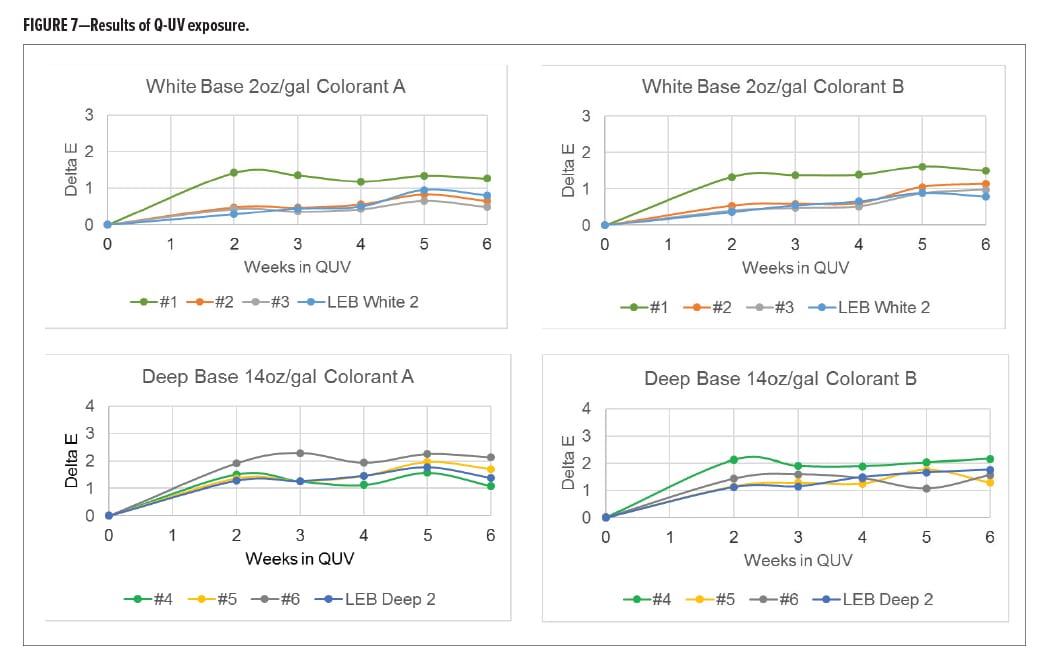
Adhesion
To evaluate adhesion on non-mineral substrates, several materials that can be typically found on building exteriors were selected (mild steel, galvanized steel, PVC). For the sake of clarity, the results shown in Table 4 are presented by paint system: each of the White Bases is associated to the corresponding Deep Base (#1 and #4, #2 and #5, #3 and #6).
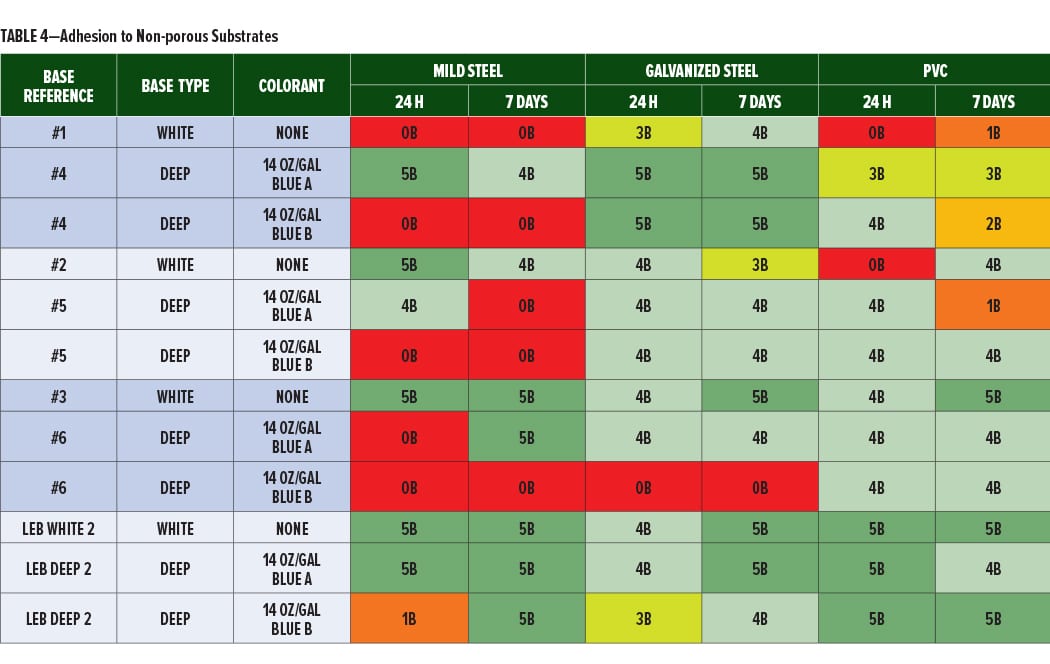
Regarding the White Bases, only product #1 exhibits some limitation on steel and PVC. For Deep Bases, we notice that some tinting pastes, such as colorant B in our study, may have a negative impact on adhesion properties when added in high quantity. The PA-LEB provides very good adhesion on substrates tested, even in the case of the clear base when blended with the required quantity of colorant. Strength of adhesion of the LEB technology is demonstrated by the performance obtained with the most critical tinting pastes.
Mud-crack Resistance
As shown in Figure 8, at the end of the mud-crack resistance test, small cracks can be seen on the paint #2 film. This is due to a lack of flexibility of the polymer used in this coating, which leads to failure in parts where dry film thickness is higher. This would restrict the usage of this product to smooth surfaces only. Paint #1 exhibits very small cracks, while product #3 and the LEB White 2 formulation pass the test. The flexibility of the PA-LEB allows for consideration of application over a wide range of surfaces with good resistance to micro cracking.
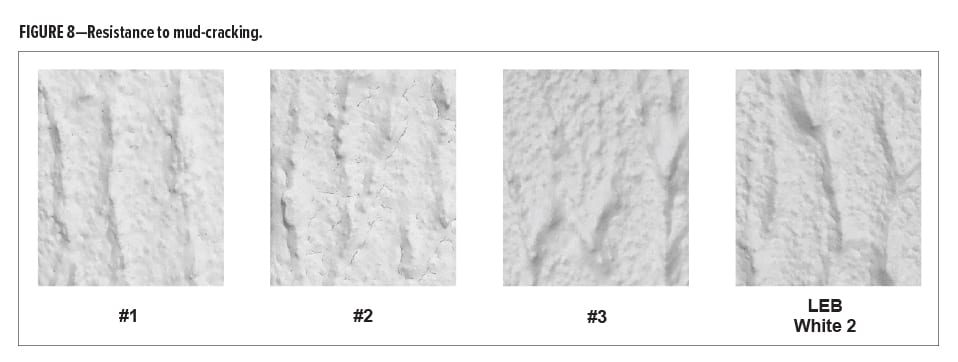
Crack Test on Wood
The crack test is commonly used to evaluate wood coatings. Nevertheless, for our study, it is complementary to the mud-crack resistance test. The aim is to also assess flexibility properties of the coating, but with additional information on resistance to water absorption and the ability of the coating to protect exterior wood prone to dimensional change under temperature and humidity fluctuations (Figure 9).
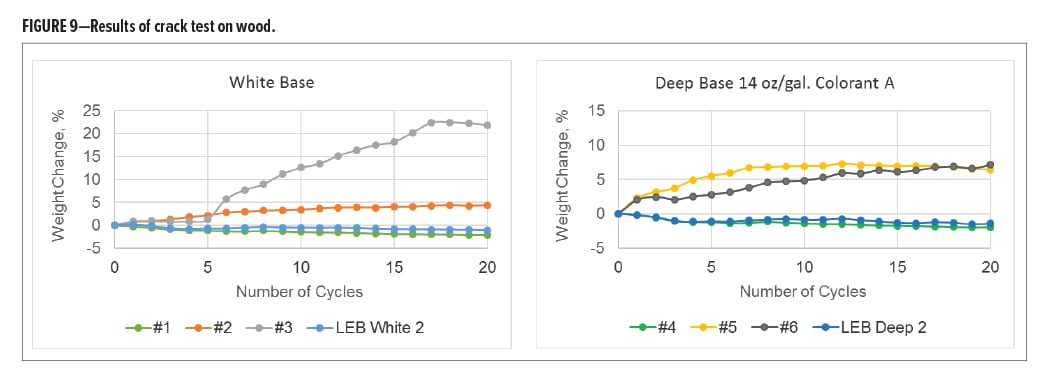
On White Base #3, a fast weight increase starts after five cycles, due to water absorption in the wood. Despite the good flexibility of the film highlighted in the previous test, after a few additional cycles some cracks start to appear because wood expansion is too extreme: the product fails due to a lack of water resistance. On product #2, a slow weight increase is measured over the successive cycles. In this case, wood swelling stays below a critical limit, and the film resists the deformation. In the longer term, the same defect as is evidenced by paint #3 could probably occur. The White Bases #1 and LEB White 2 pass the test without significant weight change, except a small decrease due to the wash-out loss. A similar phenomenon most probably happens with other paints as well, but it is masked by the water absorption.
The result obtained with each Deep Base is roughly the same as the one corresponding to the White Base from the same range: on samples #5 and #6 a weight increase is measured, evidencing water absorption through the film. The paint #6 and the LEB Deep 2 exhibit high water resistance, despite the severe aging conditions. The presence of colorant in high quantity does not really have a significant impact on performance of these formulations.
CONCLUSION
A new pure acrylic latex has been designed based on the proprietary LEB technology platform. It provides outstanding exudation and efflorescence resistance to exterior paints, with very low VOC content. Extensive analysis of exudates has shown that the LEB platform reduces the quantity of exudate from the paint film. Comparative studies have demonstrated excellent performance of the new PA-LEB in exterior flat paint formulations, especially for deeply tinted products. The excellent adhesion properties, flexibility, and weatherabilty of the binder provides long-term protection on a wide range of substrates.
The new PA-LEB latex minimizes many of the common problems associated with the application of water-based exterior paints, in particular, problems such as resistance to early rain and exudation of water-soluble components. This technology provides a new level of performance in “all weather” water-based paint.
References
- Schoff, C.K., “Coatings Clinic: Efflorescence, Frosting, Surfactant Leaching/Staining,” CoatingsTech, 9 (2) 60 (February 2012).
- Secher, M. and Fream, A., “New Generation Binder for Low-exudation, Waterborne Exterior Masonry Coatings,” ECS Conference, 2013.
- Secher, M. Bousseau, E., Fream, A. and Schmuck, J-M., “How to Avoid Problems of Exudation and Efflorescence in Semi-flexible Exterior Masonry Coatings,” Pitture e Vernici, European Coatings, 8-16 (February 2015).
- ASTM D 7190–10 (2011)—Standard practice to evaluate leaching of water-soluble materials from latex paint films.
- EN 16105:2011—Paints and varnishes. Laboratory method for determination of release of substances from coatings in intermittent contact with water.
- EN ISO 7783:2011—Paints and varnishes. Coating materials and coating systems for exterior masonry and concrete. Determination and classification of water-vapour transmission rate (permeability).
- EN 1062-3:2008–Paints and varnishes–Coating materials and coating systems for exterior masonry and concrete–Part 3: Determination and classification of liquid-water transmission rate (permeability).
- Künzel, H., “Simultaneous heat and moisture transport in building components. One- and two-dimensional calculation using simple parameters.” PhD thesis, Universität Stuttgart, Germany, 1994.
